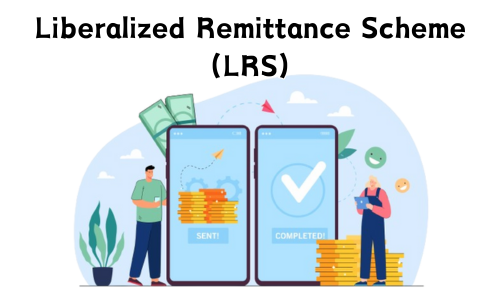The LRS full form is Liberalised Remittance Scheme. It is a foreign exchange policy initiative introduced by the Reserve Bank of India in 2004. It intended to simplify and streamline the process of remitting funds outside India.
This scheme helped Indians overcome international fund transfer restrictions as set by the FEMA (Foreign Exchange Management Act), 1999. Under LRS, resident individuals can freely remit funds up to a certain limit for various permissible transactions involving a current or capital account.

Liberalised Remittance Scheme
Liberalised Remittance Scheme is applicable to all residents including the minors. If a minor has to apply for this scheme, Form A2 has to be filled and duly signed by the minor’s guardian. Under the Liberalised Remittance Scheme, residents of India are permitted to remit up to USD 250,000 for one financial year which is from April – March. The remittance can be made for any permitted current or capital account transactions or for both. However, only residents are covered under the Liberalised Remittance Scheme. This scheme is not applicable to corporates, partnership firms, HUF, Trusts, etc. The remittances made under this scheme can be merged with the family members by complying with the terms and conditions. This merging is not allowed for other family members for capital account transactions such as opening a bank account/investment/purchase of the property if they are not the co-owners/co-partners of the overseas bank account/ investment/property. Finally, transactions that are not authorized by FEMA are also not applicable under this scheme. The capital transactions permitted under the Liberalised Remittance Scheme are as follows.
- Open an account in a foreign country.
- Purchase a property abroad.
- Make investments in a foreign country.
- Establish wholly-owned subsidiaries and joint ventures (JV).
- Extend loans in INR to the NRIs.
LRS scheme for NRIs
The LRS scheme applies to the residents of India, and thus, the remittance takes place through a savings account. Non-Residential Indians are not supposed to have any savings accounts in Indian banks. Thus, they cannot remit funds from India, but they are permitted to transfer funds from NRO, NRE, and FCNR accounts abroad as per the regulations and requisite documentation:
- They are permitted to transfer up to USD 10,000 from an NRO account.
- No limitations apply to payments made from an NRE or FCNR account.
- The Liberalised Remittance Scheme has made it simpler for Indian citizens to manage financial transactions abroad.
- You can use the funds for debt repayment, education, and other needs. You can also invest outside of India, which is a great method of diversifying your investment portfolio.
Benefits of Liberalised Remittance Scheme in India
- Diversification of investment: The LRS allows individuals to diversify their investment portfolio by investing in foreign assets such as stocks, bonds, mutual funds, and real estate.
- Overseas education: The LRS enables individuals to remit money for education-related expenses such as tuition fees, living expenses, and books. This allows students to pursue higher education in foreign universities and colleges.
- Medical treatment: The LRS allows individuals to remit money for medical treatment outside India. This is particularly helpful for those requiring specialised medical treatment unavailable in India.
- Travel: The LRS enables individuals to remit money for travel-related expenses such as tickets, hotel bookings, and other expenses.
- Start-ups and business investments: The LRS allows individuals to invest in foreign businesses, start-ups, and joint ventures. This helps entrepreneurs and business owners expand their businesses globally.
- Gift and donations: The LRS enable individuals to gift or donate money to their family members or charitable organisations outside India.
Liberalised Remittance Scheme availability
The Liberalised Remittance Scheme is available to the following individuals and circumstances:
- The Foreign Exchange Management Act states that LRS is available to all resident individuals, including minors and students.
- The eligible citizens must have an Indian bank account, a valid Permanent Account Number (PAN), and a passport.
- They can use the remitted amount for educational, business, personal, or other purposes
RBI guidelines for outward remittance
Outward remittance indicates the transfer of funds from an Indian account to a foreign account. As per the RBI guidelines, outward remittance can be paid through a demand draft issued in the individual or the beneficiary’s name. You can also open a bank account outside India to maintain foreign accounts. Here are some of the steps to do the same:
- Choose a bank branch that is an authorised dealer through which all payments will be made.
- Make sure to carry your PAN card.
- Follow the Anti-Money Laundering (AML) and KYC (Know Your Customer) guidelines.
- Fill out Form A2 to purchase foreign currency.
- Last but not least, banks are prohibited from providing any credit facilities to residents under LRS.
FAQs
Liberalised Remittance Scheme limit?
The LRS, a resident individual can remit up to USD 250,000 per financial year for permissible transactions. The LRS limit for education, medical treatment, employment, emigration, travel, investment, etc., is the same as mentioned. However, you can not use the remittances for margin trading, buying lottery tickets, real estate, etc.
Tax on Liberalised Remittance Scheme?
Profits gained from overseas investments made through LRS are taxable in India depending on the investment’s holding period. Investments over two years are considered long-term capital gains and impose a tax of 20% on the total profit earned. Profits earned from investments below two years are taxed at normal income tax slab rates.
Under the LRS scheme, you are liable to pay a 5% TCS (Tax Collected at Source) for remittances exceeding the limit of Rs. 7,00,000. However, you can claim a refund for the deducted TCS while filing ITR (income tax return) using Form 26AS.
